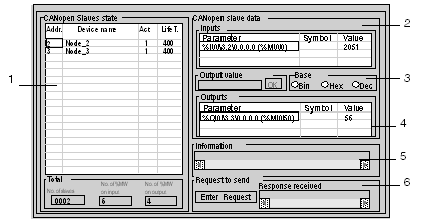|
Debug
|
|
|
(Original Document)
|

|
Number
|
Element
|
Function
|
|---|---|---|
|
1
|
CANopen Slaves state
|
This zone displays all the slaves (also called nodes) on the CANopen bus. A faulty slave is displayed in red, when the fault disappears, it is displayed in blue. If there is no fault, it is displayed in black. Selecting a slave updates zones 2, 4, 5 and 6.
Act.: indicates whether the slave was activated in the Sycon configuration (1=activated, 0=deactivated)
Life T.: Life Time.
In our example, we display two slaves (or two nodes); these are the two nodes of our Sycon configuration.
Note: When a node is displayed in red, you can obtain the causes of the error by clicking on it. The information line is automatically updated with diagnostic information.
|
|
2
|
Inputs
|
When a slave is selected, this zone contains the list of words, which are associated with it on input.
A clearer explanation is given with the display of the CANopen topological address (%IW\3.2\0.0.0.0) and reserved memory area in the PLC (%MW0).
If node 2 is selected, then the previous illustration is displayed; if node 3 is selected, the screen changes and displays the %IW of node 3.
|
|
3
|
Output value
|
When an output word in zone 4 is selected, its value can be modified by entering a new value then clicking on the OK button.
|
|
4
|
Outputs
|
When a slave is selected, this zone contains the list of words that are associated with it on output.
A clearer explanation is given with the display of the CANopen topological address (%QW\3.2\0.0.0.0) and reserved memory area in the PLC (%MW50).
If node 2 is selected, then the previous illustration is displayed; if node 3 is selected, the screen changes and displays the %QW of node 3.
|
|
5
|
Information on
|
When a slave is selected (click in zone 1), this zone contains its last diagnostic message, and to obtain information on the TSX CPP 110 card, simply click on the table header.
|
|
6
|
Request to send
|
This zone is used to send an SDO request. Parameter syntax is identical to that used to transfer SDOs using READ_VAR and WRITE_VAR requests. Pressing the Enter Request button makes the request input fields appear.
|